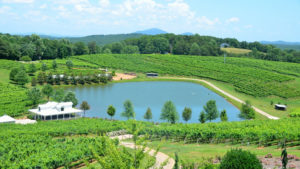Water resources, both for irrigation and aesthetic purposes, serve a vital role in the operations of any vineyard or winery. Most of the time, water bodies and algae live in harmony. However, almost everywhere where water is stored, algae problems occur. Stagnant water, higher temperatures, and high concentration of Nitrates and Phosphates, all contribute to the occurrence of harmful algal blooms.
 For wineries and vineyards, the presence of toxic blooms in the irrigation water can significantly limit crop yields and threaten the health of employees and guests. Field workers are at risk of inhaling toxins when an overhead irrigation system is used with algae-affected water. The symptoms of exposure include rash, vomiting, shortness of breath, and in rare cases can cause death. Although the knowledge about human health hazards related to the consumption of crops exposed to cyanotoxins is limited, it appears that when certain crops are exposed to environmentally realistic concentrations of microcystin, this toxin can accumulate to levels where even a small serving would exceed the WHO guideline value for tolerable levels.
For wineries and vineyards, the presence of toxic blooms in the irrigation water can significantly limit crop yields and threaten the health of employees and guests. Field workers are at risk of inhaling toxins when an overhead irrigation system is used with algae-affected water. The symptoms of exposure include rash, vomiting, shortness of breath, and in rare cases can cause death. Although the knowledge about human health hazards related to the consumption of crops exposed to cyanotoxins is limited, it appears that when certain crops are exposed to environmentally realistic concentrations of microcystin, this toxin can accumulate to levels where even a small serving would exceed the WHO guideline value for tolerable levels.
Algae can also pose an operational and financial challenge, clogging the irrigation system and therefore limiting its functionality. To reduce algae, one of the common methods is the use of algicides. These, however, can cause algal cell rupture, releasing intracellular into the environment. Moreover, copper-based algaecides are negatively impacting plant growth and the environment.
Seeking a sustainable solution for a healthy ecosystem of the water body, a vineyard in California uses an interactive ultrasound algae control system developed by LG Sonic. MPC-Buoy system monitors water quality in real-time and based on this data it activates adjusted ultrasonic frequencies, that affect the buoyancy of algae. Without access to nutrients and sunlight, algae naturally sink to the bottom of the reservoir and are degraded by the bacteria present. The technology has been developed in cooperation with universities and proven to be safe for fish, plants, and humans. Systems are currently used in 96 countries worldwide.














